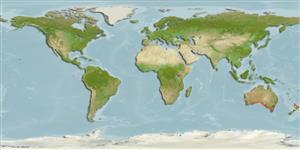Environment: milieu / climate zone / depth range / distribution range
Ecologie
marien demersaal; diepte ? - 60 m (Ref. 33616). Temperate; 28°S - 43°S
Eastern Indian Ocean: southern Australia, from Western Australia to New South Wales and Tasmania.
Grootte / Gewicht / Leeftijd
Maturity: Lm ? range ? - ? cm
Max length : 20.0 cm SL mannelijk / geslacht onbekend; (Ref. 33616)
Korte beschrijving
Morfologie | Morfometrie
Dorsale stekels (totaal): 8 - 9; Dorsale zachte stralen (totaal): 13-15; Anale stekels 0; Anale zachte stralen: 13 - 15; Wervels: 30 - 31. Adults have scute-like lateral line scales, a prominent white-edged dark blotch on the first dorsal fin, a broad pale band on the caudal fin, and blackish green color on the inner surface of the large pectoral fins (Ref. 33616).
Found in bays and coastal marine waters, over the continental shelf (Ref. 33616).
Levenscyclus en paargedrag
Maturiteit | Voortplanting | Paaien | Eieren | Fecunditeit | Larven
Neira, F.J., A.G. Miskiewicz and T. Trnski, 1998. Larvae of temperate Australian fishes: laboratory guide for larval fish identification. University of Western Australia Press. 474 p. (Ref. 33616)
Status op de Rode Lijst van het IUCN (Ref. 130435)
Gevaar voor de mens
Harmless
Gebruik door de mens
Visserij: van geen belang
Meer informatie
Lokale namenSynoniemenMetabolismePredatorenEcotoxicologieVoortplantingMaturiteitPaaienPaaiaggregatiesFecunditeitEierenOntwikkeling van de eieren
ReferentiesAquacultuurAquacultuurprofielKweeklijnenGeneticaElectrophoresesErfelijkheidZiektesVerwerkingNutrientsMassaconversie
Tools
Speciale rapporten
Download XML
Internetbronnen
Estimates based on models
Preferred temperature (Ref.
123201): 15.1 - 19.6, mean 17.1 °C (based on 124 cells).
Fylogenetische diversiteitsindex (Ref.
82804): PD
50 = 0.5000 [Uniqueness, from 0.5 = low to 2.0 = high].
Bayesian length-weight: a=0.00676 (0.00325 - 0.01404), b=3.06 (2.88 - 3.24), in cm total length, based on LWR estimates for this (Sub)family-body shape (Ref.
93245).
Trofisch niveau (Ref.
69278): 3.5 ±0.3 se; based on size and trophs of closest relatives
Weerstandsvermogen (Ref.
120179): Gemiddeld, minimale populatieverdubbelingstijd 1,4-4,4 jaar (Preliminary K or Fecundity.).
Fishing Vulnerability (Ref.
59153): Low vulnerability (14 of 100).
